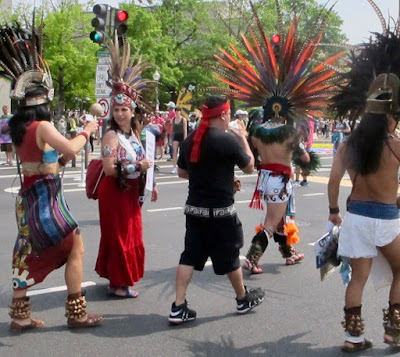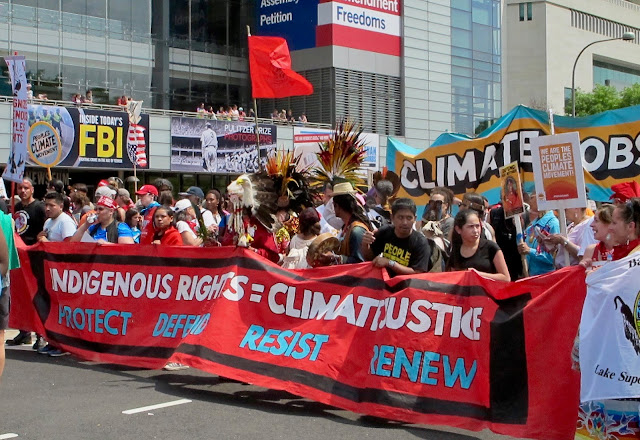This article appeared in 2017 in Rural America In These Times. For more on topics like this, see my book, American Apartheid: The Native American Struggle....
“We are at a major movement moment,” says Judith LeBlanc, a member of the Caddo Nation of Oklahoma and director of the Native Organizers Alliance (NOA), which helps indigenous advocacy groups build their organizations and capacity. LeBlanc watches tribal members from around the country gather near the U.S. Capitol to lead the April 29 People’s Climate March, seen here. She credits the past year’s Standing Rock demonstrations against the Dakota Access Pipeline for bringing awareness to indigenous struggles and to the continued threats to land and water by a range of industries.
 |
| Grass dancer Winfield Wounded Eye. |
“Standing Rock was the largest continuous protest in U.S. history,” says LeBlanc. As a result, she says, a network of tribal leaders and grassroots people and groups have coalesced around the issue of climate justice. “We have the land base, the people, the traditional knowledge and the sovereignty that will ground climate action for the twenty-first century. The power of our beliefs and history can be a guide for all people.” This is already happening, she adds, recalling that Standing Rock was not just about the concerns of that one reservation but about the fears of everyone whose water was endangered by building an oil pipeline across the Missouri River.
The attention that the Standing Rock actions generated led to two Native groups being included in planning for the 2017 climate march, says LeBlanc—NOA and the Indigenous Environmental Network, which was prominent in the Standing Rock anti-pipeline actions. Eventually, this connection resulted in the placement of tribal participants at the head of the D.C. procession, where they lead the 150,000-person march. At the same time, a similar number of participants take to the streets in marches around the country and the globe.
 |
| Chief Arvol Looking Horse holds press conference. |
In Washington, Indian humor leavens the seriousness of the occasion and the reminders of the horrific environmental devastation wreaked on vulnerable indigenous communities. A covered wagon labeled “Colonialism” and pierced with arrows rolls along behind tribal marchers carrying signs declaring “Honor the Treaties,” “Keep It In the Ground” and “Mni Wiconi” (Lakota for “water is life”).
Miguel Muñiz, a member of a traditional Aztec dance troupe who hails originally from Mexico City, explains: “As indigenous people, we know about resilience as well as resistance. We’ve been doing that forever.” He pauses. “Well…since 1492.”
In addition to the larger issues of climate change and climate justice, Sioux people gathered in D.C. had an immediate problem on their minds. According to Rosebud Sioux leader OJ Semans, an official of the national intertribal group, Coalition of Large Tribes, dozens of Sioux are marching to protest efforts to revive the Keystone XL pipeline. The line is now slated to cross their territory on its way to the U.S. Gulf Coast. It would transport the dangerous, corrosive tar-sands oil whose extraction has devastated Canadian tribal lands and turned stretches of Canada’s boreal forest into moonscapes of open-pit mines and wastewater lakes.
Semans calls the pipeline a “zombie”—something the tribes helped defeat during President Obama’s administration, only to have it rise again, thanks to the new administration and its fondness for moribund fossil-fuel energy sources and companies.
The People’s Climate March takes place at a critical moment for the planet, says Faith Gemmill, an executive of the Alaska grassroots coalition REDOIL (Resisting Environmental Destruction on Indigenous Lands). In a pre-march event earlier in the day in Washington, Gemmill decried a new presidential executive order that aims to resume offshore oil drilling, including in the highly sensitive Arctic ecosystem. She told the gathered crowd, “We need to shift the energy paradigm now for humanity to survive.”
 |
| An Aztec dance troupe joins the march. |
Faith Spotted Eagle, of the Yankton Sioux Tribe, in South Dakota, and Melina Laboucan-Massimo, of the Lubican Cree First Nation, in Alberta, Canada, say their own communities have already begun the transition to green energy. In addition, Spotted Eagle tells Rural America In These Times, seven Sioux tribes in South Dakota are collaborating on the Oceti Sakowin (Great Sioux Nation) Power Authority. A wind-energy project, it is on track to become one of the country’s largest, with the ability to provide electricity regionally as well as to member tribes.
After the march, Muñiz sits in a bus stop on Constitution Avenue, near the Washington Monument, with his orange-and-brown-feathered Aztec dance headdress bundled up beside him. He says he traveled to join the marchers from his current home in the D.C. suburbs. He made the decision to do so because he mourned the loss of progress on climate change since “the person currently in charge” was inaugurated.
“I felt we were already fifty years behind,” says Muñiz. “Now, things will get worse.”
Muñiz recalls the term “tree-hugger,” which is often used as a putdown. He has a different perspective. “We should all be tree-huggers,” he says. “We have to take care of Mother Earth. She’s the only one we have.”
 |
Offerings to an angry god: marchers leave their signs on the steps the EPA headquarters in D.C.
Text and photographs c. Stephanie Woodard. |






